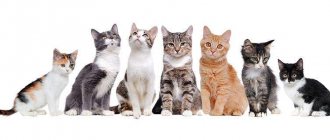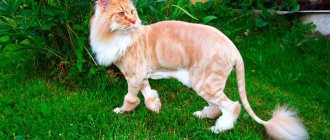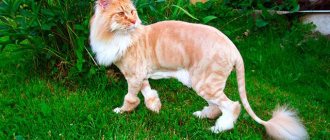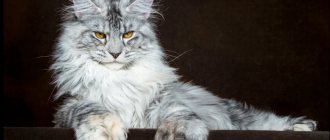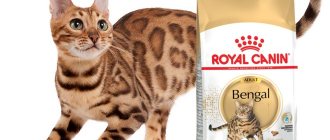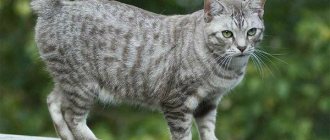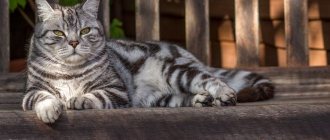The population of outbred cats has not been counted or classified in any way. They contain a fantastic cocktail of genes. And the “six handshakes” theory, widespread among people, is easily transferred to four-legged meowing “nobles” - family traits are easily recognized on their faces and in color.
And yet, street cats are a separate caste: with an individual character, health characteristics and maintenance rules.
History of the barn cat
The hypothesis of universal kinship is not an allegory at all. Geneticists conducted a study of 797 animals and found that they descend from at least 5 common ancestors on the maternal line. Among the test subjects were both purebred and barn cats. So a homely mongrel and a tribal aristocrat Persian are not so far from each other.
It has been scientifically proven that the founder of the genus was a wild steppe cat. It still lives in the space from the Far East to North Africa, confirming the powerful natural immunity and ability of the genus to survive. After this, is it any wonder why a yard cat adapts to any living conditions?
Archaeologists claim that next to humans, these animals appeared somewhere in the Fertile Crescent region (on the modern map, an arc from Turkey to Libya). At this time, people began to master agriculture, food supplies attracted rodents, and cats followed them. This is how the first wave of migration of these animals occurred and no one needs to be convinced that they were all outbreds.
After 2.5-3 thousand years, cats spread to North Africa and Europe. The active stage of domestication of these useful animals has begun. But until now, people have not completely tamed their wayward cats.
Life of street cats around the world
A new collection of photographs tells the story of the “Great Odyssey” of street cats around the world, from exotic Morocco to mysterious Japan.photo: nationalgeographic.com
For 18 years, Tuul and Bruno Morandi photographed people, cities and landscapes around the world. While traveling, they accidentally began accumulating additional photographs of friendly, furry creatures.
In Tuul and Bruno's book, The Great Cat Odyssey, cats lounge in front of the bright blue buildings of Chefchaouen in Morocco, jump over ruins in Greece, and curiously watch fishermen in Japan, expecting them to be distracted by the animals. there will be an opportunity to steal some fish.
The couple saw the charismatic creatures during a work trip and couldn't resist the temptation to photograph the cats they met. After collecting enough photographs, they asked their editor about the collection. The editor agreed, and they began collecting animal photographs with a new focus.
Photographers compare photographing cats to photographing people. “For us it’s almost the same,” says Tuul Morandi, “because we’re the kind of photographers who like to take snapshots of life on the street.” Before communicating directly or photographing the subject, the couple tries to capture genuine, sincere moments when people and animals behave naturally. If cats allow them, photographers pet and pet the furry creatures after the photos are taken.
Cats in different cities tend to have similar habits, according to photographers, and like people, some cats are more modest and shy than others. While “wild” cats are afraid of people, feeling sincere hostility towards them, homeless and street animals are sometimes surprisingly friendly.
Some cats around the world are incredibly shy; in Japan, the animals the couple met were not shy at all. According to Tuul, they knew that people were good. Perhaps the fear of man disappeared because of the opportunity to get some food.
In Japan, people are especially kind to cats, who even have a “special relationship with fishermen,” Tuul says. The animals are believed to bring good luck, and there are temples throughout the country where people can worship them. Cats are also something of a tourist attraction in Japan. Every traveler must visit one of the cat islands.
Culture, religion, history and legends are integral to the public perception of outdoor cats. They say that the Prophet Muhammad gave sermons while holding his beloved cat on his lap. When he discovered that the animal was sleeping on his robe, he simply cut off the sleeve rather than disturb the cat's sleep. “In most Islamic countries, such as Morocco or Turkey, people have a special relationship with cats,” Tuul explains, “because the Prophet Muhammad loved cats.”
However, not everyone loves stray cats. In most places, wild cats are considered the most dangerous predators. Conservationists fear the animals could harm wildlife. It is widely accepted that cats kill a lot of wildlife outside of homes. A 2013 study published in the journal Nature Communications attempted to qualitatively assess the harm caused by stray cats. The study found that in the United States, free-roaming pets kill between 1.3 and 4 billion birds and between 6.3 and 22.3 billion mammals per year.
The study was controversial, and the results were criticized by some as "inaccurate." This is because there are no official reports on how many stray animals live in the United States, and research into cat behavior is typically conducted where there are some. The unusually high density of cats interferes with the experiment, making it nearly impossible to get an accurate estimate.
Despite the controversy surrounding cats' overall environmental impact, people around the world enjoy furry pets.
In Lamu, an island off the coast of Kenya, street cats are part of their cultural history of the country. In Greece, animals are protected by law. “Cats are part of street life,” says Bruno. 12/23/2018 17:03
Comments
No comments yet
Please log in to post a comment.
You can also log in via:
Vkontakte Odnoklassniki
I agree to the processing of my personal data. More details
tags: photos of stray cats, cats, cat photos, stray cats
Is there a street breed?
The division based on appearance happened much later:
- The history of breeds begins in 1000. Around this time, the first mentions of the Norwegian forest cat date back to this time. She is also considered the ancestor of the Siberian longhaired population.
- Later, Siamese, Abyssinians, Egyptian Mau, Persians and Turkish Angora were identified. Even the names clearly show the region from which they all migrated to Europe.
- 1758 Swedish naturalist Carl Linnaeus introduced the concept of Felis catus, a binomial name for the species.
- 17 years later (1775), his colleague from Germany von Schreber supplemented this section with the name Felis silvestris, identifying wild cats as a separate group.
- 1871 The first official cat show took place in London - 170 animals were shown in 25 categories.
From that moment on, the cat world was divided into purebred purebreds and simple street cats.
No one would dare to claim that outbred cats have any characteristic features. The point is not only in their diversity, but also in their amazing adaptability. Even formerly pampered pets quickly adapt to the street.
They have offspring with any homeless partner and thereby replenish the population of outbred animals.
There is a street breed of cats: they are counted not on the basis of size, build and color, but on the basis of the “cat’s soul.” Some of them value freedom much more than close communication with people.
Health and life expectancy
Most four-legged street dwellers are in good health and free of any genetic diseases. This feature was formed over centuries in wild conditions and was passed on to modern domesticated outbred cats.
Strong immunity is the basis for the long life of tailed mongrels (which does not negate the need for their vaccination and treatment for parasites). On average they live about 10–12 years. Among them there are often true centenarians, living up to 16–17 years.
Domestic mongrel pets usually live much longer than their counterparts who were not lucky enough to find loving owners. This is influenced by a well-fed life, regular care and the opportunity to use veterinary help in case of illness. Street animals must search for food on their own and often die, unable to cope with disease and hunger, becoming a victim of a dog attack or freezing to death.
Appearance of outbred cats
Classification of outbred cats is carried out in standard ways: by weight and size, by coat length, by color.
By weight and size:
- large (over 7 kg);
- medium (4-7 kg);
- small (up to 4 kg).
Additionally, the height and length of a mongrel cat are considered. Sometimes the weight of the animal does not reach the required values due to its light bones, but its body is long and has high legs. Such cats are included in the first group. The same applies to small ones, when small height is compensated by significant weight.
Wool length:
- long-haired;
- semi-longhaired;
- shorthaired
The type of hair in cats is determined by a set of specific genes passed on to them from their parents: the L- allele is an attribute of short hair, and ll characterizes the preference for long and semi-long hair. Depending on the genetic pedigree of mongrel cats, long-haired parents may produce short-haired children.
In color, the genotype also comes first. It is impossible to guess the color of the offspring of outbred cats in advance, and no one sets such a task. The colors of street tramps offer a wide choice for every taste - from pure white to tiger mixed with tortoiseshell.
How to distinguish a purebred cat from a mongrel animal
At first glance, the differences lie on the surface. If a cat has reddish short hair, a characteristic color-point color and bright blue eyes, then no one doubts that this is a purebred Siamese. But brown pupils, a sixth toe or an overly large mask instantly exclude this aristocrat from the purebred group.
Which animals fall under the definition of outbred:
- In the first place is the culling of breeding animals. It includes all individuals that are not suitable for breeding and exhibition. Such cats cannot be called outbred, but they are also not considered to be among the elite cohort.
- Next come the mixed breeds - the owners did not keep track of the walking cat, but she delighted them with mixed offspring. The appearance may be impeccable, a fake pedigree can deceive an expert, but as soon as it comes to kittens, everything immediately falls into place. Mestizos do not guarantee quality children.
- The final group is ordinary outbred cats, at first glance one can immediately identify 10 generations of street strays. They come in all sizes, coat types and colors.
The listed animals belong to the group of domus - good companions for their owners, but without certain characteristics of the breed or with its unconfirmed characteristics.
It happens that outbred cats and their elite brothers can only be recognized by expert felinologists. An example of such camouflage is the rare Arabian Mau breed. In its white and red color variants, it is simply impossible to distinguish it from an ordinary village cat.
Let's move on to the technical aspects of shooting
Lighting
The long shutter speeds required when shooting in low light are only suitable for sleeping cats. It is better to photograph vigorous cats actively moving their skin, whiskers, and ears in good natural light. Ideally, on the street in the morning or evening (“golden hours”) or on the balcony, where the cat will happily bask in the sun: the model’s “smile” is guaranteed.
Flash
Flash should be used to a minimum. In any case, this applies to the camera’s built-in flash. Firstly, too harsh lighting will be unpleasant for the cat. Secondly, the color of the skin may be distorted, and the eyes will turn out to have glare. It’s better to do without a flash altogether or, as a last resort, use a diffuser. The ideal option is an external flash that will not hit you head-on.
Shooting mode
Cat photography is the closest thing to portrait photography, so the most suitable mode would be the camera's portrait or aperture-priority mode. The wider the aperture, the more the background will be blurred - with a non-uniform background this can give good results. Sports mode or fast shutter speed settings are great for photographing cats in motion.
White balance
Even with a well-chosen background, whenever possible, try to check whether the camera reproduces the colors correctly. White spots should turn out white. So take a couple of test shots and adjust the white balance manually. As a last resort, if the color could not be reproduced correctly, try converting the photo to black and white.
Photosensitivity
If you want to take a photo in low light, you still shouldn't resort to using a flash. Better to increase ISO. But it's not easy to avoid noise in the image, so take photos with different light sensitivity settings so you can choose the best one later.
Lenses
A telephoto lens will be very useful in a photo shoot with a cat on the street. With it, you can maintain a distance sufficient for the cat to relax and the pictures to turn out natural. A telephoto lens with built-in image stabilization will ensure shooting at longer shutter speeds without blurring the image.
papadimitriou/Depositphotos.com
Character and habits of outbred cats
The breeds share some common behavioral traits. But you won’t be able to predict the character of a mongrel cat by its appearance. Although, if his ear is torn and his tail is broken in three places, we are talking about a typical street bully.
The opinion about the obligatory gratitude of yard cats for shelter and food is also greatly exaggerated. The freedom-loving striped pet will graciously accept food, sometimes allow itself to be stroked and even purr on its owner’s lap. But freedom and the street are more important to him, and he does not recognize the authority of a person over himself. It’s not for nothing that they say that a cat walks on its own.
Another behavior scenario is a complete coincidence of the characters of a cat and a person. Here an idyllic picture emerges when the animal does not take its eyes off its adored owner, runs after him through the rooms and uses any excuse to climb onto his lap.
Thanks to this, yard cats have earned a reputation as grateful and sympathetic companions.
The habits of former street cats rarely change when they find a home. The excitement of the hunt does not subside, the desire for uncontrolled reproduction does not stop, and sooner or later their independence forces them to retire under the sofa. In addition, they do not immediately forget life from hand to mouth and are ready to overeat around the clock.
Everything changes if a purebred cat is spayed or neutered. The character becomes calmer, the level of loyalty to the person and the desire to communicate with him increases. Aggression is expressed extremely rarely - the biological rhythm adapts to new conditions.
Features of the learning ability of street cats
It has been noticed that outbred kittens show more abilities than their purebred relatives. This cannot be called a characteristic feature, but professional trainers confirm this opinion. It’s not for nothing that the first artists of the famous “Yuri Kuklachev’s Cat Theater” were Kutka and Stepka, found on the street.
Yard kittens are more susceptible to the conditions of home life. They often grow up to be very sociable cats with a soft, good-natured character and affection for family members.
Advantages and disadvantages
Despite the fact that yard cats do not have such exclusive characteristics as their purebred counterparts, they are nevertheless not without merit.
- Lasting immunity. Breeding breeds using selective breeding methods has greatly weakened the immune system of animals. This is why the life expectancy of street cats is many times higher than that of purebred pets. Yard cats have strong protective functions of the body and are able to resist many infections.
- Personality Such animals tend to be docile in nature. They become very attached to the owner who picked them up on the street.
- Reproduction. Since yard cats do not need a purebred partner, finding a mate for them to reproduce will not be difficult.
- Indispensable in the household. Outdoor cats are excellent mouse hunters. Nature endowed the animal with these qualities, and it is among the domestic representatives of the family that this instinct is much more developed.
- Price. You don't need a big investment to get a pet. You can pick up a cute, albeit not purebred, kitten on the street. Some cats even choose their own owner, coming to visit and “imposing” themselves.
- Exhibitions for yard cats. You heard right. Indeed, there are special exhibitions designed for outbred cats. On them, judges evaluate the external characteristics of the animal and its grooming.
The main and, perhaps, the only drawback of street cats is their unpredictability of character. Stray cats are careful in expressing their emotions, therefore, when taking such an animal from the street, you cannot be sure that it has a calm, easy-going disposition. Otherwise, mustachioed-striped tramps successfully compete with their purebred brothers.
Is it worth taking home stray cats?
The world is not without kind people, and the ever-decreasing population of stray animals always needs human help. The number of outbred cats in homes is several times higher than the number of their well-bred counterparts.
Veterinary experts consider three motives for which people take outdoor cats into their homes:
- compassion and desire to reduce the number of suffering animals;
- You don’t have to pay for a street kitten;
- a variety of types of feline “mongrels”, among which there is always a type suitable for “adoption”.
It has been noted that representatives of the yard cat breed almost never end up on the street again. People take full responsibility for the life of a stray animal and treat it with the same care as they treat expensive elite breeds.
Most often we are talking about yard kittens - in adulthood, animals are much less likely to find a new home.
Choosing a purebred cat
The decision is best made after the consent of all family members. Attention is drawn to the following circumstances:
- Age. A young cat will more easily enter a new environment and adapt to it. She had not yet developed the habits of a wandering life, and her character had not hardened in the struggle for survival.
- Health. Ordinary street kittens traditionally have strong immunity and natural endurance. Unlike purebred cats that undergo inbreeding, they rarely have genetic mutations. A healthy kitten should be playful, easy to run and jump, with shiny, even fur, pink gums and clean mucous membranes.
Appearance also plays a role in the selection process. They look at her first of all - after all, the aesthetic desire to own a beautiful animal overshadows everything.
The task is greatly simplified when it comes to the children of a domestic mongrel cat. Here the parents are already known (at least one of them), the kitten is under supervision and warm, and the mother cat has adequate feeding and the opportunity to raise her offspring.
No matter how healthy and active a mongrel kitten may seem, it must be shown to a veterinarian. Neglected childhood illnesses can turn into big problems.
Strengths of mongrels
Each purebred cat is unique and valued for some of its exceptional characteristics. Yard mustaches may in some ways not be comparable to their purebred counterparts, but they have a lot of advantages:
- Health. The life expectancy of mongrels is usually longer than that of purebred purrs, because the former have a stronger and more lasting immunity to most street infections. Selection work weakens the protective functions of the cat’s body.
- Temperament. Domestic breeds have the most flexible and gentle character. If such a cat is picked up on the street, then its joy will know no bounds - it will become attached to its owner for life.
- Knitting. Finding a partner for a yard pet will not be difficult. Most likely you will have many options to choose from. Waiting for a new offspring is always a mystery, because it is impossible to predict what coat color, color and eye shape the future kittens will have. It is quite possible that such a kitten will become the founder of a new breed.
- Help with housekeeping. Catching an annoying rodent will not be difficult for a mongrel; they have a well-developed natural instinct.
- Exhibitions. There are exhibitions for outbred pets, where the external characteristics of purrs and their grooming are assessed. It’s great that yard breeds also have the opportunity to show themselves in all their glory.
- Price. Anyone can buy a yard pet. Usually they come to visit themselves, offering to leave themselves. In this case, it is almost impossible to refuse.
Features of caring for outbred cats
There are no differences in the responsibilities for keeping outbred and purebred cats. Both the first and second require equal attention:
- The fur is combed out, especially in long-haired animals. A beautiful fur coat is considered a universal indicator of health and psychological state. If it loses its shine and the hairs do not lie flat, then the animal has problems.
- The mucous membranes of the eyes and nose must be kept clean. To do this, they are periodically processed and unsightly crusts are removed.
- The ears are carefully cleaned with a cotton swab or swab.
- If necessary, trim the claws.
- The teeth of the descendants of feline mongrels usually remain healthy for a long time, but from time to time they also need to look into their mouths.
The only relaxation in maintenance and care is the absence of the need to select an appropriate gentleman for a mongrel cat. Here the choice is so great that no one has any difficulties.
Feeding mongrel cats
Feeding a mongrel street dweller can be a bit of a hassle. There are fewer problems with babies, but if a cat has managed to live in freedom and is accustomed to picking up food from the ground, it is almost impossible to re-educate it.
- At an early age, babies are given diluted goat's milk or special infant formula. Outbred kittens separated from their mother prematurely have not yet learned to eat and will require additional attention.
- For adolescents, the diet is increased by boiled minced meat in a liquid consistency or age-appropriate industrial food.
- Closer to six months, meat, fish, dairy products, vegetables and fruits are introduced into the cat’s menu.
- It is necessary to provide feed yeast and vitamin and mineral supplements. No matter how strong the natural immunity of a purebred cat may be, its support is mandatory.
- There must be water next to the food. The animal's access to it is left free around the clock.
Find out also: “What to feed kittens of different ages.”
Choosing cookware is not a difficult task. Plastic bowls are convenient and inexpensive, but their porous structure traps microscopic food debris. Therefore, it is necessary to thoroughly wash surfaces to prevent the growth of bacteria.
Those with large mustaches are the most picky about dishes. If they cling to the sides of the bowl, the cat begins to experience discomfort.
Pros and cons of outbred cats
Advantages and disadvantages of purchasing an ordinary, outbred kitten.
| pros | Minuses |
| Low cost or free | It is impossible to make money from breeding and selling kittens |
| Good immunity and health | Not allowed to participate in exhibitions |
| Possibility to choose appearance | |
| No problems in content | |
| No special feeding requirements |
Inviting a purebred cat into your home is a noble act that will be impossible to beat in the future. Because true nobility can only be with a plus sign!
